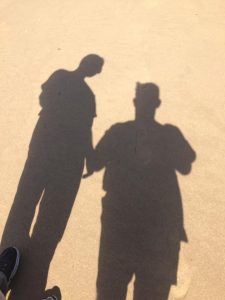 I remember one night, after a few pints a mate candidly confessing that “normally when I walk into a bar or busy place my eyes automatically scan the room looking for the hardest looking man. When I see him, my mind then imagines how the fight will begin, and it will play, rewind and replay the action until I have beaten him. What the fuck is that all that about?”
I remember one night, after a few pints a mate candidly confessing that “normally when I walk into a bar or busy place my eyes automatically scan the room looking for the hardest looking man. When I see him, my mind then imagines how the fight will begin, and it will play, rewind and replay the action until I have beaten him. What the fuck is that all that about?”
I tried to reassure him it was only a story in his head, and that he did not have to act out. But then of course he told me, as I knew, that he was often caught up in bar brawls. And in these brawls he always felt that he was responding to someone “being out of order” or “looking for aggro” and he was merely righting this ‘wrong’. The chat kind’a left me thinking about all the bar brawls and street fights l’d ever seen, and this fighting was not just found in Fife. I’d seen it the world over.
righting this ‘wrong’. The chat kind’a left me thinking about all the bar brawls and street fights l’d ever seen, and this fighting was not just found in Fife. I’d seen it the world over.
So, why the violence? The conversation made me return to a question that has echoed in my head for years “Why all the talking about violence and the need to watch violence among young men?
It was therefore apt that our reading group (NHS staff and researchers), read and discussed Levine’s (1997) Waking the Tiger: Healing Trauma. The book is about trauma. This topic brings him to discuss how some people 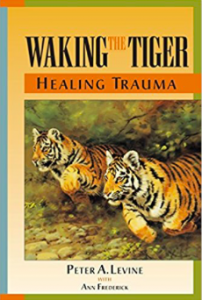 try to cope with trauma through exercising violence repeatedly in cycles. He argues that many people suffer from trauma but are unaware of this until they recognize certain symptoms or behaviour. Centrally he wants us to think about our reactions to events and how this can create energy that becomes trapped in the body. I’d like to share some of this with you if you have time.
try to cope with trauma through exercising violence repeatedly in cycles. He argues that many people suffer from trauma but are unaware of this until they recognize certain symptoms or behaviour. Centrally he wants us to think about our reactions to events and how this can create energy that becomes trapped in the body. I’d like to share some of this with you if you have time.
“When people are overwhelmed and cannot successfully defend themselves, they often feel ashamed. When they act violently, they are seeking justice and vengence for having been ashamed” (p. 180).
Trauma is more prevalent than we might think, according to Levine. He points out that the definition of trauma is unhelpful because it assumes that trauma is related to events “outside of the usual human experience” (p. 24). Alternatively, he points out the obvious fact that each human being is unique so events that cause trauma in one person might not in another. Research has illustrated this, some people suffer trauma after a car crash or experience of war but others don’t. Interestingly, Levine asserts that many of us have experienced trauma in our lives but we have ignored the sensations in the body that telegraph trauma and/or we are not aware that our unhelpful behaviour is linked to these experiences. The key is to look at symptoms of trauma or specifically how sensations in the body cause people to behave in certain ways (p. 66).
Levine’s theory, ground breaking at the time, was that trauma causes energy to become trapped in the body. When this is the case often our behaviour is linked to avoiding these sensations caused by this trapped energy. Basically, Levine has watched the natural world and witnessed the flight, fight and freeze response of animals. We have all seen the wild life documentaries where a Cheetah is chasing then catches an gazelle. Both are running at 90 mph and then the gazelle is caught. It appears limp and dead in the jaws of the Cheetah. However if the Cheetah is distracted the antelope may burst into life and run for its life. Watch this clip of this Impala doing exactly this flight and freeze when confronted with an overwhelming foe, and then escapes shaking out the fight, flight and freeze .
The point is that the gazelle is running at 90 mph and then as it is captured 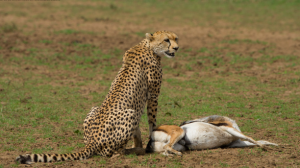 the nervous system shuts everything down so that the gazelle feels no pain. Levine argues that this causes the energy of the flight to be trapped in the body. If the gazelle then has the opportunity to escape the nervous system takes off the brake and the gazelle uses this energy to burst into life to flee the danger. Once it has fled to safety it will continue to shake out the excess energy from the flight reflex. This is Levine’s point is that what we are witnessing the flight, fight and freeze response that all mammals (including humans) have deep in the hard drive.
the nervous system shuts everything down so that the gazelle feels no pain. Levine argues that this causes the energy of the flight to be trapped in the body. If the gazelle then has the opportunity to escape the nervous system takes off the brake and the gazelle uses this energy to burst into life to flee the danger. Once it has fled to safety it will continue to shake out the excess energy from the flight reflex. This is Levine’s point is that what we are witnessing the flight, fight and freeze response that all mammals (including humans) have deep in the hard drive.
In this way he draws on the three integrated systems of the human brain: Reptilian brain (instinctual: flight, fight and freeze), the mammalian or limbic brain (emotions; anxiety, anger, love etc.), and the neo-cortex (rational: processing information, rational problem-solving). Fight, flight and freeze are reflex actions to threats and occur automatically because thinking about whether to fight or flee takes up too much valuable survival time. Trauma occurs when there is a shift to freeze without another shift to enable the energy necessary for fighting or fleeing to be expelled. This energy remains trapped in the body. In human being the natural reflex to expel the energy is prevented because the neo-cortex intervenes to problem-solve or comply with social conventions.
Trauma
When this energy is not able to be released it remains trapped in the body and creates trauma, as he writes “The human immobility response does not easily resolve itself because the supercharged energy locked in the nervous system is imprisoned by the emotions of fear and terror” (p. 101). “The fear of experiencing terror, rage, and violence towards ourself or others, or being overwhelmed by the energy of discharge in the mobilization process, keeps the human immobility response in place … the neo-cortex informs us that immobility feels like death” (p.104) Fear of death is to be avoided and resisted and prevents the natural conclusion of the discharge of this energy.
When this occurs there maybe a change in patterns of sleep, activity, aggression, eating and sexuality – all regulated by the reptilian brain. (p. 106 + 107).
It is Levine’s contention that many of us experience this fight, flight and freeze during our lives, but some don’t discharge the energy and unknowingly suffer from trauma. Therefore we many not be fully conscious of having experience trauma (sometimes through denial or disassociation) but its presence is felt and contributes to the motives and drives of our behaviour.
Levine argues “Much of the violence that plagues humanity is a direct or indirect result of unresolved trauma that is acted out in repeated unsuccessful attempts to re-establish a sense of empowerment”.
What he is drawing attention to the argument that though violent behaviour may provide temporary relief and an increase feeling of pride,  without a biological discharge of the energy created by trauma it is trapped in the body (see below). As a result the cycle of shame and violence returns. The organ of the trauma might be that the man who was hit as a child will feel compelled to hit as an adult. The energy behind his need to strike out is none other than the energy contained in the traumatic symptoms of childhood or adult beatings. This attraction of violence caused by trauma may explain why so many young men find themselves in a cycle of violence that they feel powerless to change.
without a biological discharge of the energy created by trauma it is trapped in the body (see below). As a result the cycle of shame and violence returns. The organ of the trauma might be that the man who was hit as a child will feel compelled to hit as an adult. The energy behind his need to strike out is none other than the energy contained in the traumatic symptoms of childhood or adult beatings. This attraction of violence caused by trauma may explain why so many young men find themselves in a cycle of violence that they feel powerless to change.
Resolving Trauma
Levine advocates Somatic Experiencing (p. 119) as the key resolving trauma and this require a rediscovery of awareness of the body and attitude of non-judgement. “Somatic experiencing is a gentle step-by-step approach to the renegotiation of trauma. It enables us to escape the fracturing of ourselves and returns us to complete and competent whole”. He argues that “These 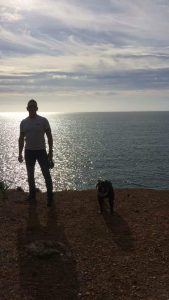 mechanisms originate in the nervous system; you experience them in the body. It is in your body – with the nervous system fully engaged and accessed through the felt sense – that you will be successful in working with it (p. 152-153). Re-engaging with the body requires us to slow down and consciously bring our awareness of our inner experience. To slow down and direct our awareness to the body so that we begin to become aware of our felt sense is the key to the process of resolving trauma. Once this is achieved Levine argues that it is possible to renegotiation trauma and allowing the energy trapped in the body to be released. An interesting definition is offered
mechanisms originate in the nervous system; you experience them in the body. It is in your body – with the nervous system fully engaged and accessed through the felt sense – that you will be successful in working with it (p. 152-153). Re-engaging with the body requires us to slow down and consciously bring our awareness of our inner experience. To slow down and direct our awareness to the body so that we begin to become aware of our felt sense is the key to the process of resolving trauma. Once this is achieved Levine argues that it is possible to renegotiation trauma and allowing the energy trapped in the body to be released. An interesting definition is offered
“A felt sense is not a mental experience but a physical one. Physical- A bodily awareness of a situation or person or event. An internal aura that encompasses everything you feel and know about the given subject at a given time – encompasses it and communicates it to you all at once rather than detail by detail” Gendlin (1981) Focusing: Bantam Books.
We might describe this felt sense as a gut feeling or even internal wisdom. By engaging with this felt sense he argues we can experience the sensation and feeling that “accompany our traumatic patterns, allowing them to complete themselves before we move on, we begin to access and transform the drivers and motivations that otherwise compel us to reinact traumatic events”. It is here that Levine’s prescription to resolve trauma echoes many of the principles and techniques of mindfulness.
This focus on bodily awareness is promoted in mindfulness training. Indeed the very definition of mindfulness revolves around achieving agency with our own awareness with an attitude of non-judgement, which includes bodily sensations: “mindfulness means paying attention in a particular way, on purpose, in the present moment non-judgementally.
(Jon Kabit-Zinn 2003) This is clearly echoed by those teaching compassion “Mindfulness involves learning to be more aware of life as it unfold moment by moment, even if these moments bring difficulties, pain and suffering … a new way of learning how to face the pressures of modern living by providing an antidote which teaches us how to cultivate kindness and compassion – starting with ourselves” (Erik van de Brink & Fritz Koster 2015). The skill of focusing awareness and seeing clearly (with mindfulness) require us to compassionately or tenderly hold what we find with this awareness. Here the emphasis is on being with what we find rather than trying to engage in problem-solving and fixing in the mind. To acknowledge and to allow sensations without trying to name and fix can seem alien because humans are habitual problem-solvers. However to bring awareness and compassion to our suffering without problem-solving is both then radical and transformative. Together mindfulness and compassion are ‘ are as interdependent as the two wings of a great bird. Together they enable us to fly and be free.’ (Tara Brach 2012)
The focus on the body is central to mindfulness practice. In her discussion of Mindfulness Based Cognitive Therapy (MBCT), Rebecca Crane (2009) also articulates the centrality of the body:
“One of the processes taking place in a mindfulness-based course is learning to trust in this unfolding and to allow space for this more intuitive, intimate knowing and understanding to emerge […] Coming to feel our experience rather than thinking and rumination involves re-learning the ability to directly perceive through the kinaesthetic sense of just feeling sensations in the body ”. (Crane 2009: 49-50)
Ultimately, she makes the valid point that we live in a body, so we are to appreciate the fullness of life we need to experience the body fully. All our thoughts, emotions, speech and actions are guided by background felt meanings, which are expressed through and experienced in the body. The human capacity for language, imagination and abstract problem-solving now means that many live in their heads, such that the body has become separated from us.
We have often lost the capacity to know what our body is feeling which can 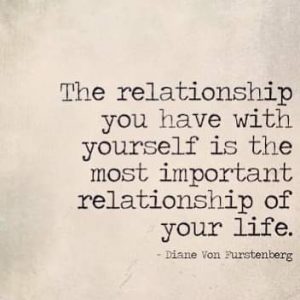 be beyond language. If we think about it we had this ability to know through our body before we had the capacity to talk. As a baby you knew when you were uncomfortable, hungry and tired but did not have access to language to articulate this to the world – knowing beyond language. The learning and insight that emerges from this deep Visceral (relating to deep inward feelings rather than to the intellect) is integrated into our thinking process and articulated verbally through dialogue – a process of translation. This brings a very unique approach the engaging with the challenges of our lives. Indeed coming to feel our experience involves re-learning the ability to directly perceive through our sense of hearing, smelling, seeing, tasting, touching and the kinaesthetic sense of just feeling sensations in the body. The philosophy and practice of mindfulness provides individuals with the practice tools to discover their innate wisdom. In doing so mindfulness has the potential to open our awareness to trauma.
be beyond language. If we think about it we had this ability to know through our body before we had the capacity to talk. As a baby you knew when you were uncomfortable, hungry and tired but did not have access to language to articulate this to the world – knowing beyond language. The learning and insight that emerges from this deep Visceral (relating to deep inward feelings rather than to the intellect) is integrated into our thinking process and articulated verbally through dialogue – a process of translation. This brings a very unique approach the engaging with the challenges of our lives. Indeed coming to feel our experience involves re-learning the ability to directly perceive through our sense of hearing, smelling, seeing, tasting, touching and the kinaesthetic sense of just feeling sensations in the body. The philosophy and practice of mindfulness provides individuals with the practice tools to discover their innate wisdom. In doing so mindfulness has the potential to open our awareness to trauma.
Certainly, Levine’s discussion of trauma brings us to reconsider why violence occurs so frequently. Unfortunately, it also provokes us to speculate on the number of people that suffer diagnosed trauma and try to deal with this trauma through violence. Perhaps by practicing mindfulness we might begin the process of slow down and bring our awareness and compassion to the bodily sensation. We may discover that we are holding energy that may be linked to trauma, and holding this energy with compassion may begin the process of freeing ourselves from habitual cycles of unhelpful behaviour – such as a cycle of violence.
Note: This article needs to be updated after reading
